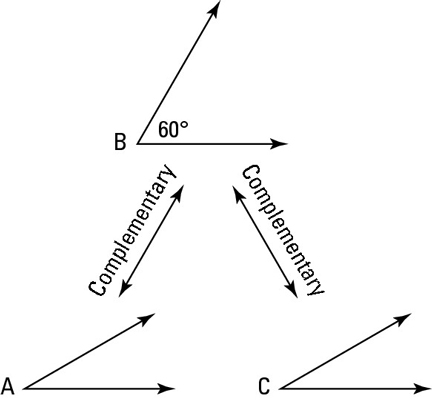

Find the supplement of the angle (30 + x)°. Hence, they are a pair of supplementary angles.Ģ. Verify if 125°, 55° are a pair of supplementary angles?Īdd the given two angles and check if the resultant angle is 180° or not. Then, from the above two equations, we can say, If ∠a and ∠b are two different angles that are supplementary to a third angle ∠c, such that, The supplementary angle theorem states that if two angles are supplementary to the same angle, then the two angles are said to be congruent. Also, the non-adjacent supplementary angles do not have the line segment or arm. The adjacent supplementary angles have the common line segment or arm with each other. The supplementary angles may be classified as either adjacent or non-adjacent.

By adding the two angles AOC and BOC, we get 180º. Supplementary Angle form 180º by adding two angles.įrom the given figure, Angle AOC is one angle and angle BOC is another angle. Learn all the concepts and improve your preparation level easily. The important geometry concepts Lines and Angles are explained on our website with detailed explanations and solved examples. One important thing in supplementary angles is the two angles need not be next to each other. By adding two supplementary angles, they form a straight line and a straight angle. If one angle is 120 degrees then the other angle is 60 degrees in supplementary angles because by adding 120 and 60, we get 180 degrees. Therefore, the requirement of supplementary angles is to have the 2 angles to equal 180 degrees.Supplementary angles are the angles that are added up to 180 degrees. Supplementary angles are 2 angles that have the sum of 180 degrees. As long as their measure is equal, the angles are considered congruent It's important to note that the length of the angles ' edges or the direction of the angles has no effect on their congruency. In simple words, they have the same number of degrees. Linear Pair Theorem: If 2 angles form a linear pair then they are supplementaryĬongruent angles are two or more angles that have the same measure. ∠1 and ∠2 are supplementary definition of supplementary ∠ M ∠ABC = 180° definition of straight line Ray AB and Ray BC form a line definition of linear pair If two congruent angles form a linear pair, the angles are right angles.

Ī linear pair forms a straight angle which contains 180º, so you have 2 angles whose measures add to 180, which means they are supplementary.

If two congruent angles add to 180º, each angle contains 90º, forming right angles. Which pair of angles are always congruent?Ī linear pair forms a straight angle which contains 180º, so you have 2 angles whose measures add to 180, which means they are supplementary. Keep in mind that since they are theorems, you could end up having to prove that they are true when you take a geometry class! There are a number of theorems in geometry that involve supplementary angles. Sure, the three angles in a triangle may add up to 180 degrees, but there are three angles in a triangle, so they are not supplementary! Theorems Involving Supplementary Angles Remember, only a pair of angles can be supplementary. This is an important property of supplementary angles - you will either have two right angles in the supplementary pair, or one acute angle and one obtuse angle. Perhaps you noticed a pattern in this list - except for one pair of two right angles, all the supplementary angle pairs had one acute angle and one obtuse angle. Let's look at some examples of supplementary angle pairs. These angles may share a common side, a common vertex, or have no points in common. In geometry, two angles whose measures sum to 180 degrees are supplementary angles.


 0 kommentar(er)
0 kommentar(er)
